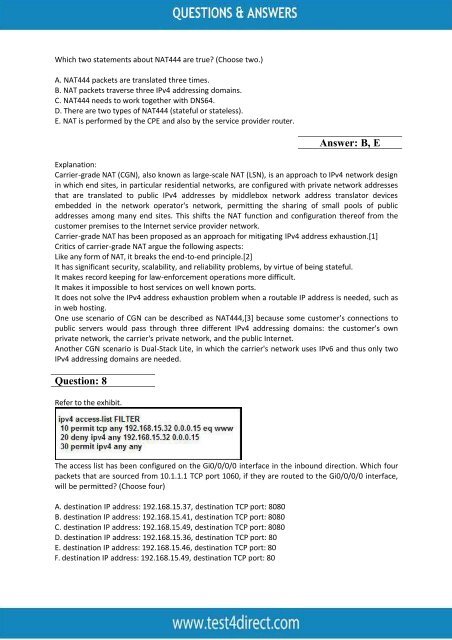640-878 Latest Exam BrainDumps
Test4Direct provides latest PDF questions of Cisco 640-878 exam. You have an opportunity to pass the Cisco 640-878 exam in one go. Test4Direct is most accurate source to prepare Cisco 640-878 exam as your success will become site’s responsibility after purchasing 640-878 exam product. There are also lots of discounts and promotion offers that you can avail. Let’s try a free demo http://www.test4direct.com/640-878.html
Test4Direct provides latest PDF questions of Cisco 640-878 exam. You have an opportunity to pass the Cisco 640-878 exam in one go. Test4Direct is most accurate source to prepare Cisco 640-878 exam as your success will become site’s responsibility after purchasing 640-878 exam product. There are also lots of discounts and promotion offers that you can avail. Let’s try a free demo http://www.test4direct.com/640-878.html
You also want an ePaper? Increase the reach of your titles
YUMPU automatically turns print PDFs into web optimized ePapers that Google loves.
Which two statements about NAT444 are true? (Choose two.)<br />
A. NAT444 packets are translated three times.<br />
B. NAT packets traverse three IPv4 addressing domains.<br />
C. NAT444 needs to work together with DNS64.<br />
D. There are two types of NAT444 (stateful or stateless).<br />
E. NAT is performed by the CPE and also by the service provider router.<br />
Question: 8<br />
Answer: B, E<br />
Explanation:<br />
Carrier-grade NAT (CGN), also known as large-scale NAT (LSN), is an approach to IPv4 network design<br />
in which end sites, in particular residential networks, are configured with private network addresses<br />
that are translated to public IPv4 addresses by middlebox network address translator devices<br />
embedded in the network operator's network, permitting the sharing of small pools of public<br />
addresses among many end sites. This shifts the NAT function and configuration thereof from the<br />
customer premises to the Internet service provider network.<br />
Carrier-grade NAT has been proposed as an approach for mitigating IPv4 address exhaustion.[1]<br />
Critics of carrier-grade NAT argue the following aspects:<br />
Like any form of NAT, it breaks the end-to-end principle.[2]<br />
It has significant security, scalability, and reliability problems, by virtue of being stateful.<br />
It makes record keeping for law-enforcement operations more difficult.<br />
It makes it impossible to host services on well known ports.<br />
It does not solve the IPv4 address exhaustion problem when a routable IP address is needed, such as<br />
in web hosting.<br />
One use scenario of CGN can be described as NAT444,[3] because some customer's connections to<br />
public servers would pass through three different IPv4 addressing domains: the customer's own<br />
private network, the carrier's private network, and the public Internet.<br />
Another CGN scenario is Dual-Stack Lite, in which the carrier's network uses IPv6 and thus only two<br />
IPv4 addressing domains are needed.<br />
Refer to the exhibit.<br />
The access list has been configured on the Gi0/0/0/0 interface in the inbound direction. Which four<br />
packets that are sourced from 10.1.1.1 TCP port 1060, if they are routed to the Gi0/0/0/0 interface,<br />
will be permitted? (Choose four)<br />
A. destination IP address: 192.168.15.37, destination TCP port: 8080<br />
B. destination IP address: 192.168.15.41, destination TCP port: 8080<br />
C. destination IP address: 192.168.15.49, destination TCP port: 8080<br />
D. destination IP address: 192.168.15.36, destination TCP port: 80<br />
E. destination IP address: 192.168.15.46, destination TCP port: 80<br />
F. destination IP address: 192.168.15.49, destination TCP port: 80
















